Laughter, music, spice: Rally a group for a hands-on feast instead of a weekend pub feed
Ethiopian cuisine is built around kinship and sharing, so order an oil painter’s palette of injera dotted with wots (stews), plus meatier options worth rolling your sleeves up for at Gursha Ethiopian.
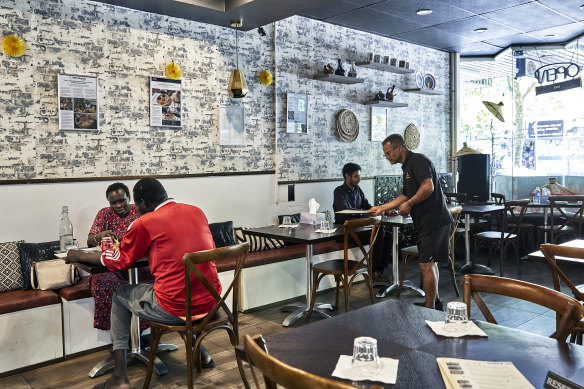
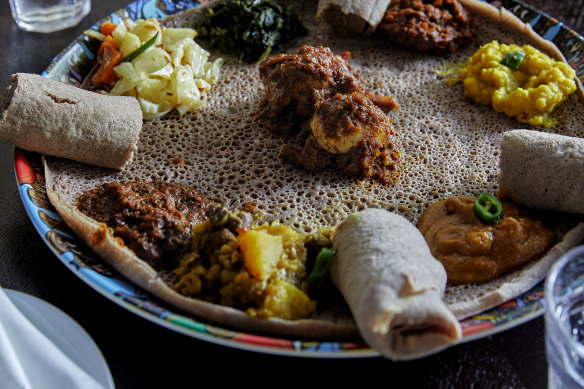
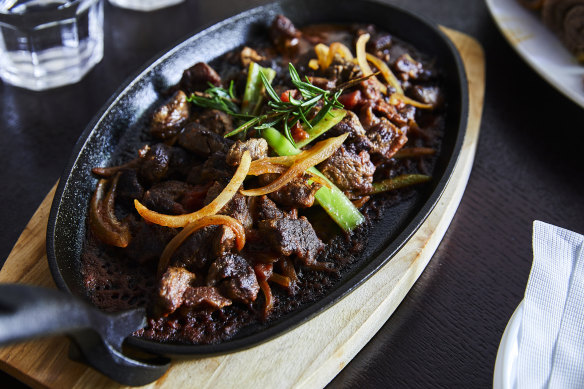
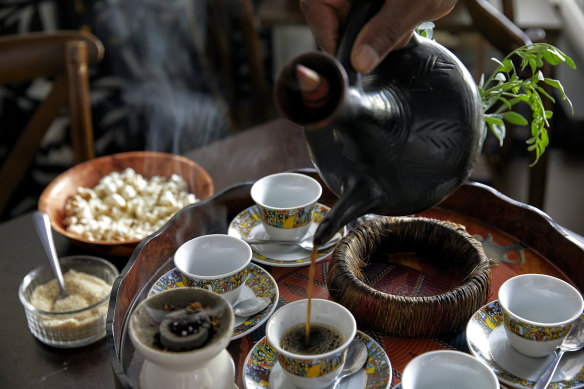
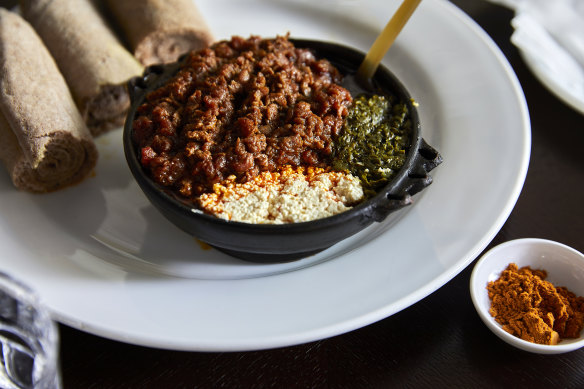
14/20
Ethiopian$
With all due respect to pumpernickel, paratha, focaccia and the bagel, Ethiopia’s injera might be the ultimate bread. It’s light and spongy and dotted with crumpet holes but also has enough heft to support brightly spiced stews. Traditionally made with water and teff (a type of tiny grain), the fermented bread is also faintly tangy, often described as a “type of sourdough pancake”. But injera is much more than a pancake. In Ethiopia, injera is life.
However, like asbestos-free parks and affordable property, injera options in Sydney are limited. In Auburn, there’s Salam and Ibrahim Eatz. Ashfield has Queen of Sheba (loved by vegans for its kik alicha split-lentil stew) and in Blacktown there’s Gursha, decorated with fairy lights.
Husband and wife Yibeltal Tsegaw and Rahel Woldearegay moved from Ethiopia to Australia two decades ago and opened Gursha in 2017. Tsegaw runs the modest dining room; Woldearegay helms the one-woman kitchen. On weekends, East African families gather around platters of injera covered in different wots (stews) like splodges on an oil painter’s palette. There’s laughter. There’s music. The air is heavy with spice and incense.

Over the past few years, I’ve seen food writers in the US and UK declare that Ethiopian cuisine is about to “take off” there. The prediction mostly exists to present a hot new take, but it’s not completely unfounded. Vegetarians are well catered for, the injera is gluten-free and the spice levels swing between soothing and a school bully’s headlock. You never walk away from an Ethiopian table thinking, “Well, that was a bit dull. Let’s just go to the pub next time.”
You may walk away smelling of berbere, though – Ethiopia’s signature spice blend containing chilli, fenugreek, powdered ginger, coriander and about a dozen other aromatic dried things. Time-wasting ingredients need not apply.
Berbere stars in Gursha’s misir wot ($18), a thick and fiery red-lentil stew, and Ethiopian flagship yedoro wot ($22), a medley of boundless flavour featuring hard-boiled eggs and long-simmered chicken legs.
Ethiopian cuisine is built around kinship and sharing, so rally a group and start with golden, lentil-filled sambossa triangles (four for $12). Crunchy chickpea and green chilli falafels (six for $12) are a smart idea, too, plus a Greek-ish house salad ($10), just because it’s nice to have some raw onion, tomato and cucumber to balance the oncoming wots. You can probably skip the peanut butter-laced tomato salad ($10) unless you’re really into peanut butter.
“You never walk away from an Ethiopian table thinking, ‘Well, that was a bit dull. Let’s just go to the pub next time.’”
The misir wot is the vegetarian main I keep coming back to, although there’s also a lot to love about the gomen ($22), sauteed kale pulsing with onions, chilli and too many spices to name. Tsegaw tells me that the most popular order is the ataklet beyeayntu ($27, pictured below), a combo of four vegetarian dishes circling a sunset-orange dollop of garlic-forward chickpea and tomato stew “shiro”, with everything seeping into more injera. Definitely worth a crack if it’s your first visit.

Injera is designed to be eaten off and eaten with, the idea being to tear a swatch of the bread and use it to pick up non-bread foods. Do it right, and you shouldn’t get any stew on your hands.
Advanced-grade injera users may perform an actual gursha: the practice of popping a little wot parcel into a companion’s mouth as a sign of love and respect. My wife says she doesn’t trust me to not spill any deep-red stews on her shirt. Fair.
Meatier options worth rolling your sleeves up for include the tibs ($26), a fragrant, home-cooking staple of beef sauteed with rosemary and onion, and mild, turmeric-yellow alicha wot ($20), which is loaded with lamb, potato, carrot and plenty of ginger.

At the other end of the heat spectrum, there’s special kitfo ($26): finely chopped raw beef marinated in cardamom-infused butter and throbbing with a mitmita spice blend. Gomen and ayip (Ethiopia’s answer to cottage cheese) are served on the side. I could happily never eat another steak tartare, but would eat this kitfo once a week if Blacktown was closer to home.
It’s unlikely that you’ll finish a meal here feeling heavy and bloated, which probably has a little to do with injera’s short fermentation process, and a lot to do with what happens when you eat Ethiopian stews with your hands. It’s more a case of considered mouthfuls here and there rather than shovelling a whole bowl of fettuccine in your face. What do we call it – mindful eating, perhaps?
If Ethiopian food is indeed about to “take off”, Gursha is the right place to get in on the ground level.
The low-down
Vibe: Warm and welcoming Ethiopian social club
Go-to dish: Special kitfo ($32)
Drinks: Traditional coffee and a few soft drinks; no booze
Cost: About $80 for two, excluding drinks
This review was originally published in Good Weekend magazine
Related Article
Continue this series
Your April hit list: The hot, new and just-reviewed places to check out, right nowUp next
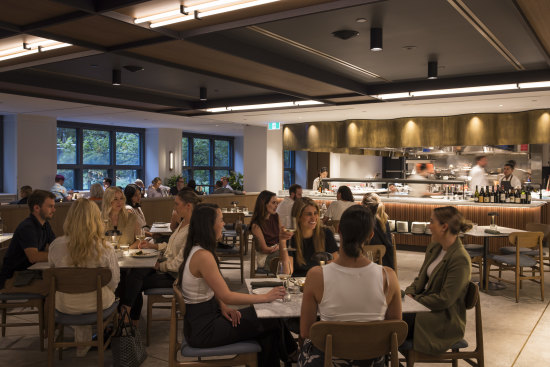
Why new hotel restaurant Sydney Common is ‘uncommonly good’
Up-and-coming talent Jamie Robertson works with former Sepia chef Martin Benn to create a seasonal menu that’s wood-fired and Japanese-inflected.
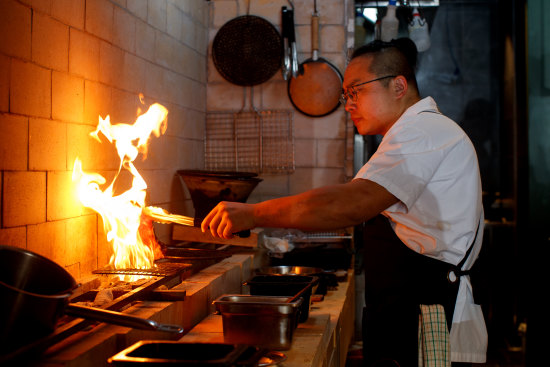
Firepop’s new Enmore Road home set to sizzle with huge open grill and a ‘crazy’ new dish
The first look at the popular pop-up that has finally found a home in Sydney’s inner west.
Previous
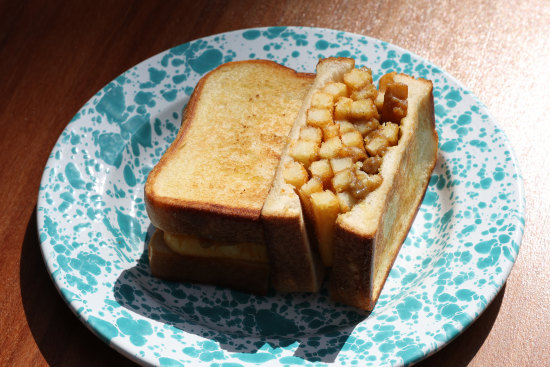
‘So damn good’: The chip butty our reviewer ordered five times in three days
From carb-loaded marvels to the Bradman burger, there’s plenty to lap up at this family-friendly cafe.
Restaurant reviews, news and the hottest openings served to your inbox.
Sign upMore:

